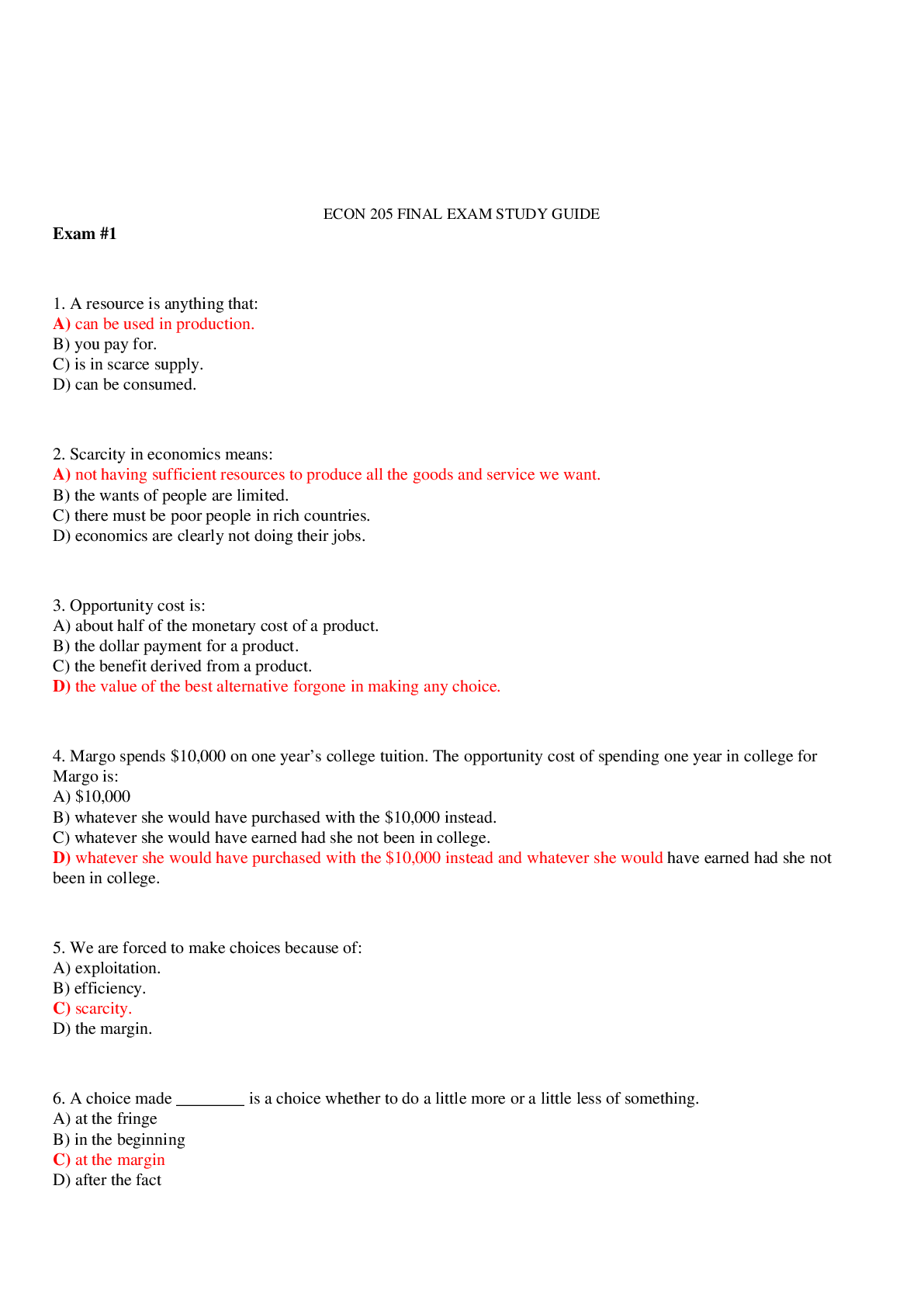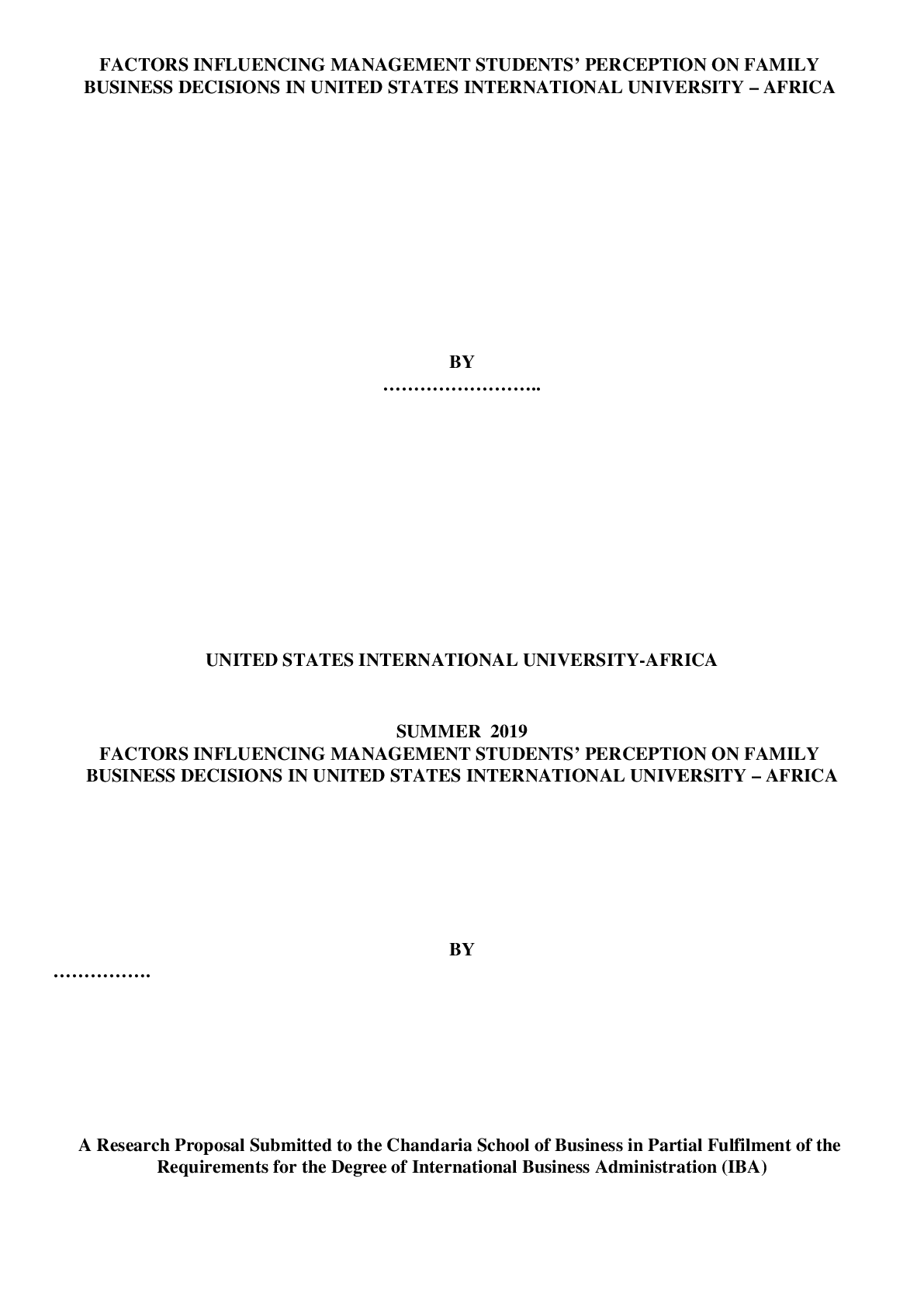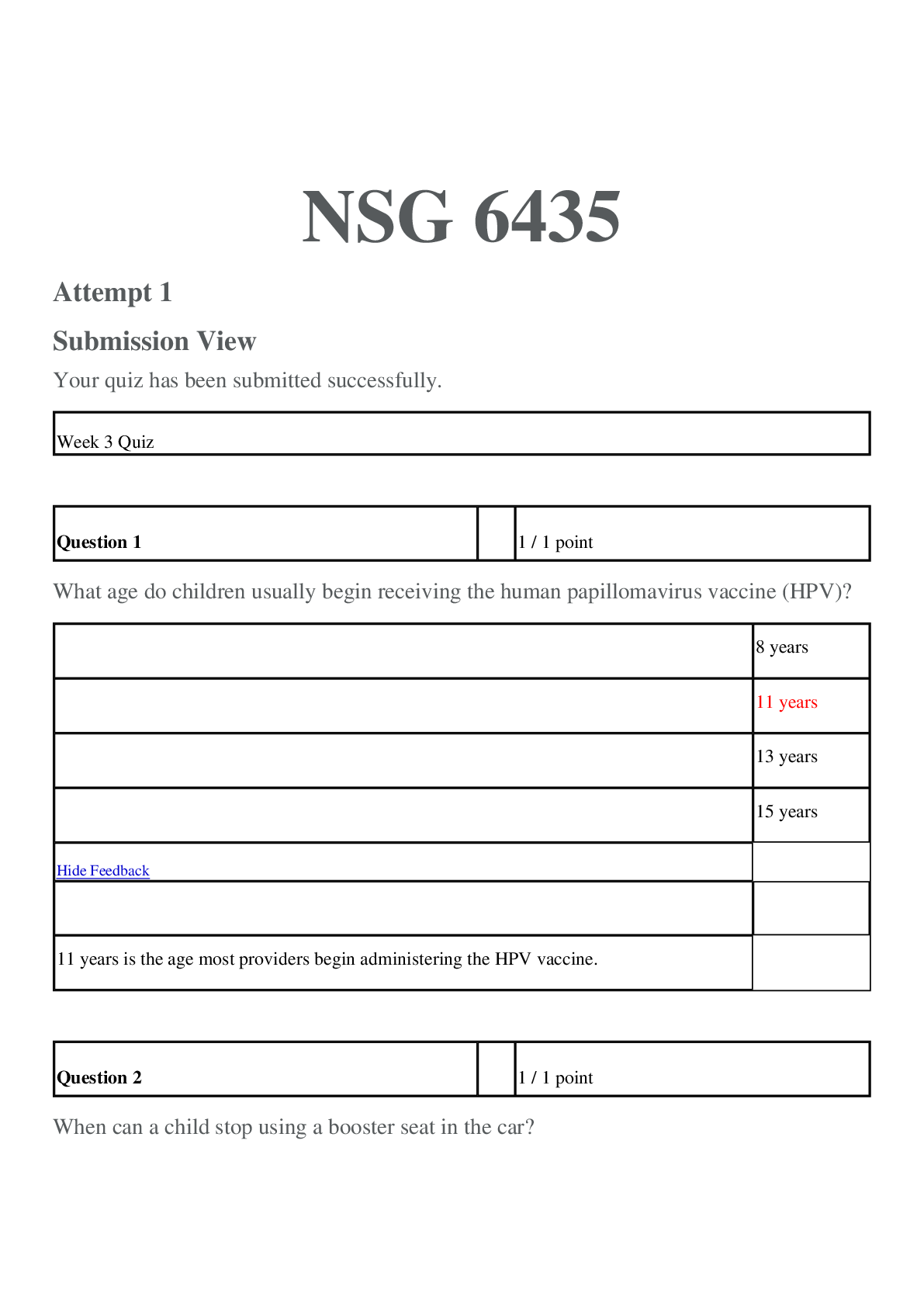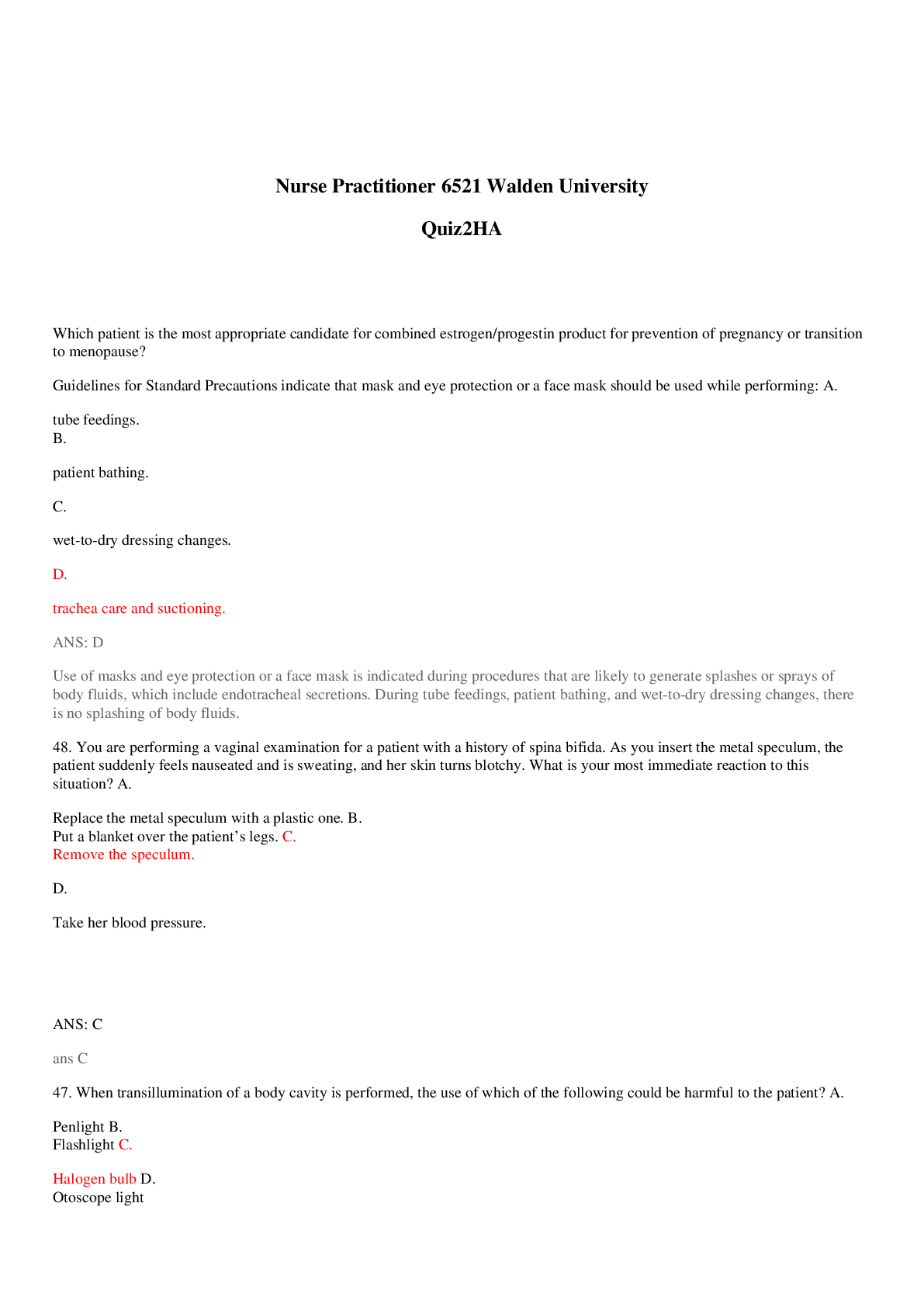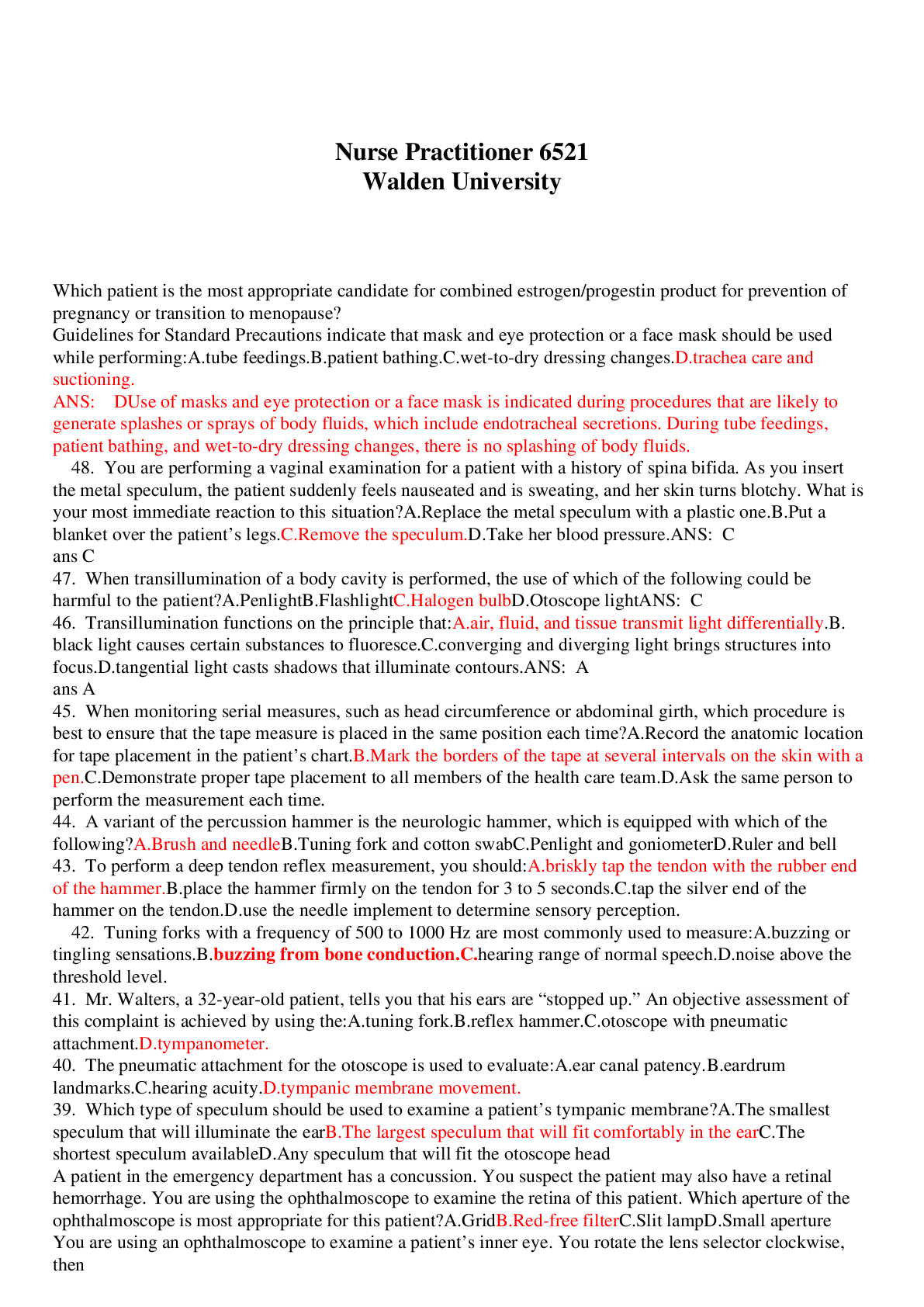ATI MENTAL HEALTH 1
Document Content and Description Below
ATI MENTAL HEALTH 1 1. As a nurse approaches a client with schizophrenia, the client looks at the nurse and says, “Back off. Leave me alone.” The client appears tense and is pacing rapidly. Whi... ch of the following is an appropriate nursing response? a. “I can’t leave you alone when you are this upset. Sit down, and try to relax.” b. “Let’s go to your room, and you can tell me what is bothering you.” c. “I will give you space as long as you control yourself. I’d like to know what is causing you to feel so tense.” d. “I will leave you alone for a few minutes while you try to compose yourself.” The nurse’s first concern is to ensure safety. To avoid escalating the client’s behavior, the nurse should stay at the comfortable distance and remain calm while stressing the importance of maintaining control. Verbal intervention is the least restrictive form of action. If the client does not respond to verbal interventions, then more restrictive measures may have to be used. 2. A nurse on a mental health care unit is providing care for a client diagnosed with schizophrenia. The client is experiencing delusional thinking. Which of the following defense mechanisms is the client using when making delusional statements? a. Projection b. Dissociation – a client detaches emotional or behavioral processes from usual conscious behavior patterns or identity. There is not indication that the client has amnesia problems c. Displacement – a client redirects an emotion from the original object to a more acceptable substitute. Displacement is not the defense mechanism used in delusional thinking d. Regression – a client attempts to reduce anxiety and conflict by returning to less mature behaviors that help the client better tolerate the anxiety. Regression is not the defense mechanism used in delusional thinking. In projection a client attributes unacceptable emotions and qualities to others. This is the defense mechanism that is operative in delusive thinking 3. A client diagnosed with schizophrenia says to the nurse, “They lied about me and are trying to poison my food.” Which of the following is a therapeutic nursing response? a. “Tell me who would do such things to you?” b. “You are mistaken. Nobody has told lies about you or tried to poison you.” c. “Tell me more about your concerns about being poisoned.” d. “You’re having very frightening thoughts.” Fear of being poisoned is a common delusion among the client with schizophrenia. The nurse is responding therapeutically to the feelings that the client is attempting to communicate. By doing this, the nurse is shifting the focus from the beliefs, which are not real, to the client’s fear, which is real. 4. A client is hospitalized with schizophrenia. During a conversation with the nurse, the client seems relaxed initially, but then com restless and begin wringing his hands. The nurse states that the client seems tens, and the client agrees. Which statement by the nurse would be appropriate at this time? a. “Did I say something wrong that made you feel tense?” b. “Do you often feel tense when you are talking to a health care provider?” c. “What were we discussing when you began to feel uncomfortable?” d. “I sometimes feel tense, too, when I am talking to stranger.” This statement seeks clarification by asking for information about when the client became tense. This open-minded question is therapeutic because it encourages further communication and expression of feeling. 5. A nurse is caring for a client whose provider has prescribed fluphenazine decanoate (Prolixin)12.5 mg IM weekly. Available is fluphenazine decanoate 50 mg per 2 mL. How many mL should the nurse plan to administer each week? a. 0.25 b. 0.5 c. 0.75 d. 1.0 6. A nurse is caring for a client admitted for depression a week ago who was started on paroxetine (Paxil) at the time of admission. The client states to the nurse, “My family would be better off without me.” Which of the following is an appropriate therapeutic response by the nurse? a. “I do not feel that you really believe that.” b. “Everyone feels this way when depressed.” c. “You sound upset. Are you thinking of hurting yourself?” d. “You’ll be better once your medication start working.” This response represents the therapeutic communication technique of showing empathy. Telling the client “you are upset” focuses on the client’s feelings, which is where therapeutic communication belongs. In addition, the nurse confronts the client who believes that “my family would be better off without me” about suicidal ideation by asking the client directly whether or not she has an intent of self-harm. 7. The nurse should document that a client is experiencing mild anxiety when the nurse observes which of the following? a. The client is extremely alert. b. The client complains of a stomach ache. c. The client paces in the day room. d. The client has dilated pupils. Mild anxiety can be therapeutic and motivating. A heightened perceptual field and increased awareness is associated with mild anxiety. 8. A nurse is caring for a college student at the campus mental-health counseling center. The student comes to see the nurse after getting a low grade in a course, and spends the entire session blaming the teacher and complaining about the lack of help seminars. The nurse recognizes this behavior as an example of which of the following defense mechanisms? a. Projection b. Displacement c. Undoing d. Conversion Defense mechanisms are processes that serve to provide relief from emotional conflict and anxiety. Displacement is a type of defense mechanism, in which the client, operating unconsciously, takes unacceptable emotions, ideas, or wishes and transfers them from their original object to a more acceptable substitute. 9. A client in a long term care facility asks the nurse to telephone her husband and ask him if he remembered to pick up his suit at the cleaners. The nurse knows the client’s husband died five years before. Which of the following is an appropriate nursing response? a. “How long were you married to your husband?” b. “Remember? Your husband died five years ago.” c. “You’ve forgotten that your husband is dead, haven’t you?” d. “You miss your husband a lot, don’t you?” This therapeutic nursing response uses empathy to validate the client’s feelings and acknowledge her experience. This is the best option because the nurse is responding to the feelings underlying the client’s comment. Instead of the disordered content. 10. A client is admitted to the psychiatric unit for depression. The nurse observes an improvement in the client’s grooming when the client comes to breakfast freshly bathed wearing clean clothes and with combed hair. Which of the following is an appropriate therapeutic response by the nurse? a. “You must be getting better. You look great!” b. “Let’s go put some make-up on to make you look even better.” c. “Why did you get all dressed up today? Is it a special occasion?” d. “You look nice after your bath and shampoo.” 11. While taking a health history from a client in the outpatient mental health clinic, a nurse observes that the client is persistent in making personal inquiries. Which of the following is most therapeutic response? a. Explain to the client that this time is for him. b. Introduce an unrelated topic to distract the client. c. Accept this behavior as a sign of the client developing trust. d. Relate to the client that you do not wish to engage in this conversation. A therapeutic relationship between nurse and client differs from a social relationship. The focus of the relationship is on the client’s ideas, experiences, and feelings. The nurse should explain this to the client. 12. A client who is bipolar states to the psychiatric nurse in the mental health outreach clinic, “I no longer take my medication because I like to feel manic.” Which of the following is an appropriate therapeutic nursing response? a. “You may feel good now, but what about when you get depressed?” b. “What do you like about being manic?” c. “You feel better when you don’t take your medication?” d. “You really follow your provider’s orders if you want to be well.” This response uses the therapeutic communication tool of validating or clarifying the client’s feelings. The client has stated a preference for being off the medication. This open-ended response acknowledges the client’s statement and allows further exploration of the subject. 13. A client admitted to the hospital with abdominal pain and GI bleeding has a colonoscopy, and colon cancer is discovered. The provider comes to the client’s room, tells the client the diagnosis, discusses treatment options, and leaves. Shortly after, the nurse enters the room and the client begins yelling at the nurse stating, “I have received lousy care here and no one cares about me.” The nurse recognizes that the client is demonstrating the defense mechanism of a. Denial b. Displacement c. Regression d. Projection. 14. A widow is brought to the clinic by her adult son, who found her at home crying. She said that she could not go on alone. He tells the nurse that when his father died six months earlier, and the family was amazed at his mother’s fortitude during and immediately after the funeral. She did not cry or seem unduly upset. The nurse recognizes that his mother had previously dealt with her husband’s death by using which defense mechanism? a. Denial b. Repression c. Introjection d. Sublimation 15. A nurse is caring for a client diagnosed with dementia. She should understand that the goal of reminiscence therapy in long-term care facilities is to a. Share memories of past experiences and events. b. Reorient clients with cognitive problems c. Stimulate and encourage social participation. d. Resolve emotional problem. 16. A nurse is caring for a client diagnosed with BPD. The client becomes attach to one of the nurses and refuses to talk with any of the other staff members. The client says the other staff members are abusive and untrustworthy. The client is using which of the following defense mechanisms? a. Splitting b. Reaction formation – expressing an attitude that is the direct opposite of one’s true feelings and wishes. c. Projection – disavowing one’s internal feelings, thoughts, or impulses by attributing them to other persons. d. Idealization. – overestimating admired qualities of another person. 17. The spouse of a chronic alcoholic client says to the nurse, “I told my husband I would leave if he did not get into treatment. Now that he is here, I feel differently. What can I do to help him?” which of the following is a therapeutic nursing response? a. “You should attend an Al-Anon meeting. The group can teach you how best to help him stay sober.” b. “You have already done a great deal by getting him here. Now, it is up to him.” c. “Are you feeling some responsibility for his drinking?” d. “Tell me more about the kind of help you feel you are able to provide at this time.” The wife is the client in this question. This response will help the wife clarify what assistance she can realistically provide without sacrificing her own needs in the process. 18. A client with dementia says to the nurse, “Everyone wants to kill me.” Which of the following statement is an appropriate nursing response? a. “Why do you think that someone would want to kill you?” b. “You are frightened. This is a hospital, and we are here to help.” c. “don’t worry. No one here wants to kill you.” d. “Who in particular do you think want to kill you?” Dementia refers to a group of symptoms involving progressive impairment of all aspects of brain function. This therapeutic response restates the client’s feelings and provides reality reorientation. 19. A nurse is caring for a client diagnosed with disorganized schizophrenia. The client does not return a visitor’s greeting and instead lies down on the bed and curls up in the fetal position. Which of the following defense mechanism is the client exhibiting? a. Regression – represents a dysfunctional attempt to reduce anxiety and conflict by returning to less mature behaviors that help the client better tolerate the anxiety. b. Symbolization – occurs when one idea or object comes to stand for another c. Repression – unconsciously removing sth from one’s awareness d. Fixation – not progressing beyond a given level of development. 20. A client was admitted to the psychiatric unit with a diagnosis of bipolar disorder. At 0300, the client runs to the nurse’s station and demands to see the therapist immediately. Which of the following responses by the burse is appropriate? a. “You are being unreasonable, and I will not call your therapist at 0300 in the morning.” b. “Why do you need to see your therapist tonight?” c. “Calm down, go back to your room, and I’ll try to get in touch with your therapist right away.” d. “You must be very upset about something to want to see your therapist in the middle of the night.” 21. Which of the following is an important short term goal for nurse to plan with a suicidal client? a. Develop more adaptive family relationships. b. Sign a contract pledging not act on suicide plans. c. Explore the motivating factor for suicide. d. No longer verbalize thoughts or feeling as they relate to suicide. 22. The nurse working with a depressed client notes that the client has no come to breakfast and finds the client still in bed in a nightshirt. The client tells the nurse, “I’m too sick to bother. Leave me alone and go help someone else who is worth your time.” Which of the following is an appropriate response by the nurse? a. “Everyone feels that way when they first start treatment.” b. “You sound very discouraged and hopeless today.” c. “You’ll feel so much better once you get up and into your own clothes.” d. “Why do you say that you are too sick to bother?” 23. The nurse in the oncology unit support to the parents of a child newly diagnosed with glioblastoma tumor of the brain. In planning care, the nurse understands the parents’ initial reaction to a potentially terminal illness in their child is a. Denial and disbelief b. Fear and anxiety c. Anger and guilt d. Depression 24. A parent brings an 18-month-old child to the emergency room. The child has sustained a fractured left femur. Which of the following statements by the parent might make the nurse suspect child abuse? a. “My child is so active and gets into everything.” b. “My child was riding a bicycle and got the right foot caught in the spokes.” c. “My child slipped out of the high chair because the strap was too loose.” d. “My child climbed up on a chair and fell down.” 25. A client has been diagnosed with anorexia nervosa. The nurse would anticipate that this client will display which of the following? a. Increased sensitivity to other’s needs. b. A poor sense of self-identity c. Exaggerated feelings of guilt d. Excessive amounts of fear and suspicion. The core issues surrounding anorexia nervosa includes alterations in self-image and self-identity. The client has an altered perception of self. 26. A female client is seen in the emergency room with ecchymosis of the trunk and face. Upon direct questioning by the nurse, the client admits to having been struck by her spouse. When offered information about shelters for battered women, the client declines stating, “I could never leave my husband because of my kids.” Which of the following is an appropriate nursing response? a. “Aren’t you worried about the safety of your children?” b. “Can you identify the situations that provoke your husband?” c. “I am concerned about your safety.” d. “I wouldn’t put up with this if I were you.” 27. A client is admitted to the detoxification center for alcohol addiction. On the day after admission, the client develops hand tremors and asks the nurse about them. Which of the following is appropriate nursing response? a. “They are permanent changes because the alcohol has destroyed your nerves.” b. “They will persist for a few days now that you are not drinking.” c. “This is unusual. We will have to notify your provider immediately.” d. “These are very typical of the seizures that are associated with alcohol withdrawal.” 28. A nurse is working in a busy pediatric emergency room. In which of the following cases should the nurse maintain a high index of suspicion of physical child abuse? a. A 14-month-old who is reportedly “clumsy” with many busies on bony prominences in various stages of healing. b. A 9 month old who reportedly nearly drowned after climbing into the tube and turning on the water. c. A 6-year-old with a fracture of the tibia and fibula, which reportedly occurred while riding a bicycle. d. A 3-year-old child with 15% burns in a splash pattern over the face and chest reportedly sustained when a tablecloth was pulled, spilling a teapot. 29. A nurse receives a call on a crisis intervention hotline from a client who threatens to commit suicide. Which would be the most important question for the nurse to ask? a. “Have you attempted suicide before?” b. “What happened to make you so desperate?” c. “How will you carry out your plan?” d. “What will you accomplish by taking your life?” This question may give the nurse important data such as the client’s location and method of self-harm. Since safety is the priority in this instance, this is the most appropriate question for the nurse to ask. 30. A nurse should recognize that MRI procedures are generally contraindicated for clients who have a fear of which of the following? a. Closed space – fear of closed spaces is the condition known as claustrophobia. b. Dark places c. Immobilization d. Needles 31. While working with a client, a nurse unconsciously attributes negative feeling to the client and becomes antagonistic toward her. The nurse is demonstrating which of the following? a. Reciprocity – used as a distractor to test the student’s knowledge of psychiatric vocabulary b. Countertransference – phenomenon of the nurse unconsciously attributing feelings about another to the client. c. Transference – client attributing feelings to the nurse. d. Self-evaluation – the nurse’s self-reflection of feelings and attitudes as they relate to a client or group of clients. 32. A nurse is admitting an adolescent female to the psychiatric unit for observation related to clinical depression. After completing the admission assessment, the nurse should give greatest priority to which of the following finding? a. The client frequently argues with her parents b. The client is getting C’s in school because she is absent a lot. c. The client smokes half a pack of cigarettes per day. d. The client gave her favorite necklace to her best friend. 33. A client diagnosed with BPD has become attached to one of the nurses who calls in sick one day. When given this news, the client breaks a glass bottle and uses it to self-inflict a deep scratch. After providing first aid, which of the following is a therapeutic nursing action in relation to the client’s behavior? a. Permit the client to remain alone. b. Ignore the client’s behavior. c. Telephone the client’s favorite nurse to talk with the client d. Help the client verbalize her feelings and reasons for acting-out behavior. 34. A college junior comes to the campus health service with reports of severe epigastric distress, and the nurse discovers the client has suffered from sever bulimia since freshman year. The client tells the nurse, “I know my eating binges and vomiting are not normal but I cannot control it.” Which of the following is an appropriate therapeutic nursing response? a. “Is there any pattern to your eating binges and vomiting?” b. “Do you have a family history of eating disorders?” c. “You are feeling helpless about changing this behavior?” d. “You must stop. You are destroying your health.” The nurse is responding to the feelings the client has expressed. Clarifying feelings is an important first step prior to exploring how to deal with them more effectively. 35. A nurse is caring for a client who is scheduled for a cardiac catheterization. When arriving for the procedure, the client reports waking that morning with butterflies in the stomach, a sense of restlessness, urinary frequency, and some difficulty concentrating while driving to the hospital. The admitting nurse should assess the client’s anxiety level as which of the following? a. Moderate b. Mild c. Severe d. Panic. 36. A client with hallucinations is admitted to the psychiatric unit. In the initial phase of establishing a therapeutic nurse client relationship, it would be appropriate for the nurse to explore which of the following? a. Perception of the presenting problem b. Description of hallucinations c. Feelings about hospitalization d. Relationship with the family In the initial, orientation phase of the nurse-client relationship, the nurse should gather data from secondary sources, establish rapport with the client and assess the client’s beliefs about the reason for therapy. 37. A nurse’s neighbor has just found out that her teenage child has died in a motor-vehicle crash. The neighbor is crying inconsolably. Which of the following is an appropriate therapeutic nursing response? a. Suggest calling the client’s spouse for him b. Ask the client if there is anything that can be done for him c. Sit silently with the client while he cries. d. Share feelings with the client regarding the recent loss of a sibling The nurse is conveying that the client’s feelings are important by providing personal time. Being silent is a communication tool that is appropriate during times of grieving. 38. The nurse asks a client who is suicidal to make a safety contract. The client states to the nurse, “I cannot make a safety contract, because I cannot promise that I will not harm myself.” In the nurse’s plan of care, which of the following initial actions is best to ensure this client’s safety when implementing the plan of care? a. Lock the doors to the unit and secure all windows so they cannot be opened. b. Remove belts, glass objects, and sharp instruments from the client’s environment. c. Have a staff member stay with the client at all times. d. Provide a relaxed and accepting environment to develop trust. 39. A client is admitted to the psychiatric unit following treatment in the ER for an intentional OD ingestion. As the nurse performs the admission assessment, the client says, “Why would you want to waste your time on a worthless person like me?” Which of the following is a therapeutic nursing response? a. “Let’s discuss your feeling more after we finish admitting you.” b. “I don’t think talking to you is a waste of time.” c. “Why do you feel the way you do?” d. “I think you are worthwhile, and I want to talk to you.” 40. A nurse should assess that the client with highest potential for suicide is a depressed client who states which of the following? a. “At breakfast today everyone was talking about me. They were all staring at me.” b. “I don’t feel like going to group therapy today. I don’t want to be with other people.” c. “I have it all figured out. Everything is going to be okay now.” d. “I don’t feel like showering or eating. I’d rather just stay in bed today.” [Show More]
Last updated: 1 year ago
Preview 1 out of 13 pages
Instant download
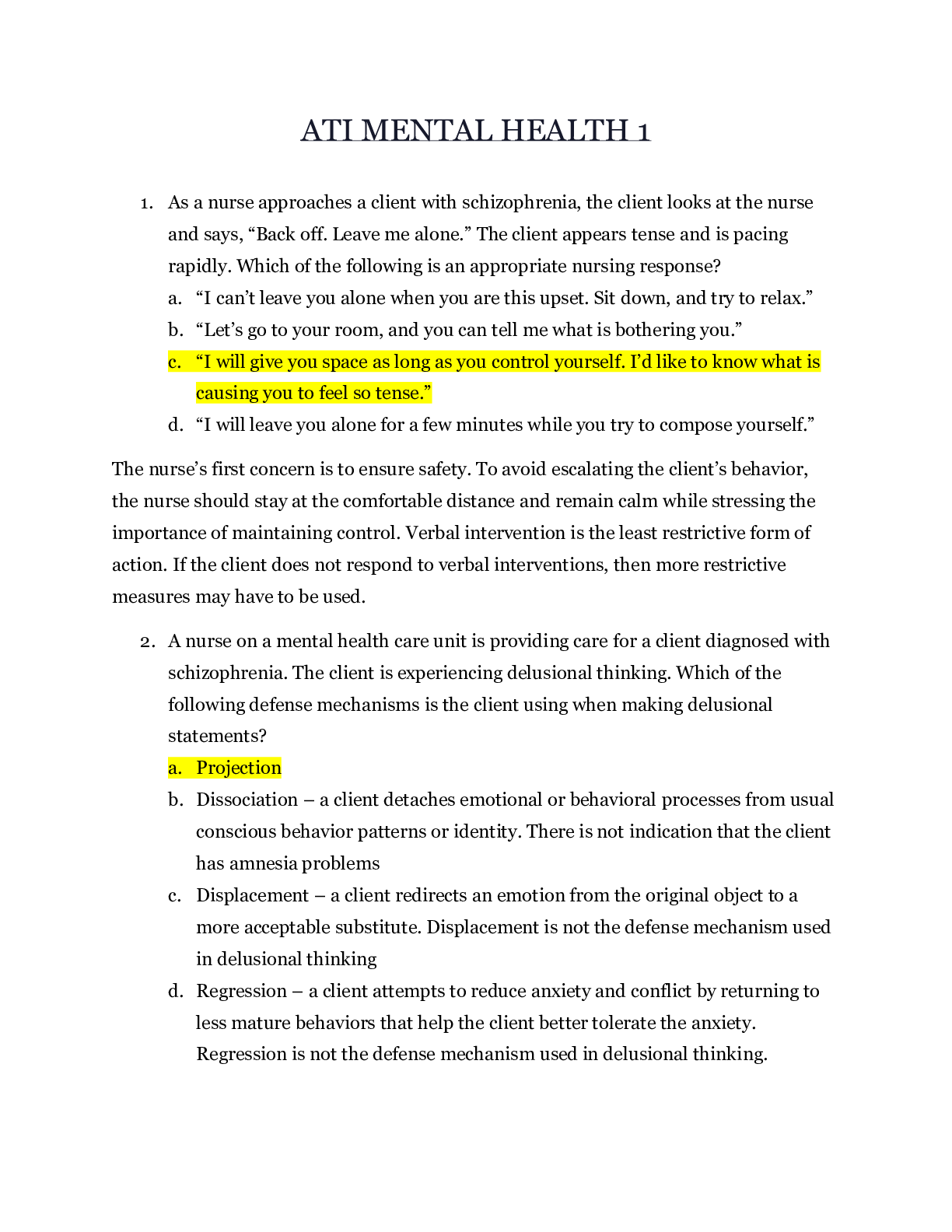
Buy this document to get the full access instantly
Instant Download Access after purchase
Add to cartInstant download
Reviews( 0 )
Document information
Connected school, study & course
About the document
Uploaded On
Jun 07, 2020
Number of pages
13
Written in
Additional information
This document has been written for:
Uploaded
Jun 07, 2020
Downloads
0
Views
136














